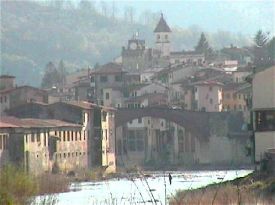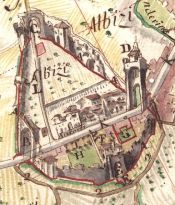History of Pontassieve
The first rulers of the territory now known as Pontassieve were nobles of the Quona family, whose Lordship is documented from the 11 C. The Quona, a branch of whom also appeared under the name Filicaia at a later date, abandoned country life and migrated to Florence at the end of the 12 C, selling, in 1207, a large part of their lands to the Bishopric of Florence.
The village of Pontassieve first developed under Florentine dominion. In 1375, Florence ordered the construction of a castle of strategic importance and the village became known as Castel Sant’Angelo. Pontassieve took its current name because of the importance of the bridge across the river, controlling access from Florence to the territories of the Mugello, Casentino and the city of Arezzo.
The first houses of the village were built around the bridge below the Florentine castle but there was little growth during Florentine times. However, at the end of the 18 C century, when the Dukes of Lorraine took power, reclamation projects and the opening of two new roads that joined Pontassieve to the Casentino and Emilia Romagna greatly increased economic growth at Pontassieve.
Under the Dukes of Lorraine, Pontassieve became so important that it was elevated to the rank of a Bishopric comprising part of the territories belonging to the valleys of the Arno and Sieve rivers.
In 1859, the building of a railway that joined Florence to Rome gave an additional impulse to the local economy. The construction of this important railway and later the contruction of the Florence-Borgo San Lorenzo railway allowed the town to develop as a modest industrial hub.
In 1861 Pontassieve was annexed to the Kingdom of Italy by the King Vittorio Emanuele II of Savoy.
Pontassieve suffered substantial damage during WW II because of its importance as a rail junction. The railways and the town itself were repeatedly bombed by Allied planes so the town as it now is results, for the most part, from post war reconstruction, although the town has retained its original mediaeval look in the centre.
The village of Pontassieve first developed under Florentine dominion. In 1375, Florence ordered the construction of a castle of strategic importance and the village became known as Castel Sant’Angelo. Pontassieve took its current name because of the importance of the bridge across the river, controlling access from Florence to the territories of the Mugello, Casentino and the city of Arezzo.
The first houses of the village were built around the bridge below the Florentine castle but there was little growth during Florentine times. However, at the end of the 18 C century, when the Dukes of Lorraine took power, reclamation projects and the opening of two new roads that joined Pontassieve to the Casentino and Emilia Romagna greatly increased economic growth at Pontassieve.
Under the Dukes of Lorraine, Pontassieve became so important that it was elevated to the rank of a Bishopric comprising part of the territories belonging to the valleys of the Arno and Sieve rivers.
In 1859, the building of a railway that joined Florence to Rome gave an additional impulse to the local economy. The construction of this important railway and later the contruction of the Florence-Borgo San Lorenzo railway allowed the town to develop as a modest industrial hub.
In 1861 Pontassieve was annexed to the Kingdom of Italy by the King Vittorio Emanuele II of Savoy.
Pontassieve suffered substantial damage during WW II because of its importance as a rail junction. The railways and the town itself were repeatedly bombed by Allied planes so the town as it now is results, for the most part, from post war reconstruction, although the town has retained its original mediaeval look in the centre.


